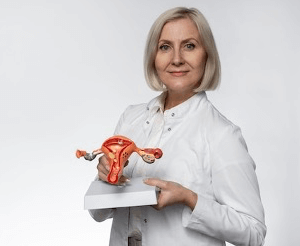
This article will explore PCOS, one of the most common endocrine disorders that affect an important number of women worldwide, specifically discussing the available methods to effectively get rid of the excess of unwanted hair, the main (and most unpleasant) cosmetic concern that comes along with this condition.
What is PCOS?
PCOS stands for Polycystic Ovary Syndrome, a complex condition that affects 6 to 20% of premenopausal women, being considered one of the most common endocrine and metabolic disorders in women of reproductive age [1]. It is mainly characterized by elevated androgen levels (such as testosterone), menstrual irregularities, and/or the presence of small cysts on the ovaries [2].

What causes PCOS and What are its Symptoms of Cosmetic Concern?

It’s not completely clear what causes PCOS. It is considered a
multifactorial disorder
, in which the influence of genetics (family history of PCOS) and environmental factors (such as obesity) may play an important role [2].
Nonetheless, PCOS is associated with
insulin resistance and higher amounts of testosterone
(the male sex hormone) compared to normal patients. This increase in the levels of testosterone is responsible for the further development and manifestation of PCOS symptoms of cosmetic concern such as
acne, alopecia, and hirsutism
[2].
Why does PCOS need hair removal?
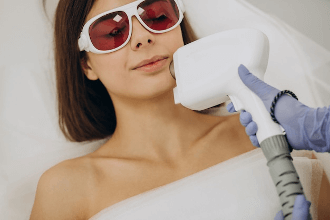
As just mentioned, one of the main clinical symptoms of PCOS is hirsutism, a condition in which terminal hair (thick and dark) starts growing in the female body following a “male pattern”, leading to the presence of visible hair in androgen-sensitive parts such as the face, neck, chest, and lower back, buttocks, and inner thighs [3].
This can be challenging to cope with. Up to 80% of women with PCOS are expected to develop hirsutism, which is considered the most upsetting and discouraging feature of the syndrome [4]. For this reason, identifying the most effective methods to remove excessive hair becomes a critical task.
How to get rid of unwanted hair?
In general, the treatment
of hirsutism focuses on a dual approach
: 1) a
pharmacological treatment
to reduce levels of androgens or insulin, and 2) the
removal of the hair
already present [5].
Hair removal alone won’t get you the desired results if the underlying hormonal imbalances are not resolved. On the other side, pharmacological treatment on its own could be partially effective, always requiring it to be combined with
hair removal methods
[5].
COMPARISON OF DIFFERENT HAIR REMOVAL METHODS
Among the different hair removal methods available, it’s safe to say that the most effective ones to ensure long-lasting hair reduction are electrolysis, laser, and IPL. Here we will describe and compare each of them, but we will start saying some words about the temporary hair removal methods that we all know, such as shaving or waxing.
1.
Temporary hair removal
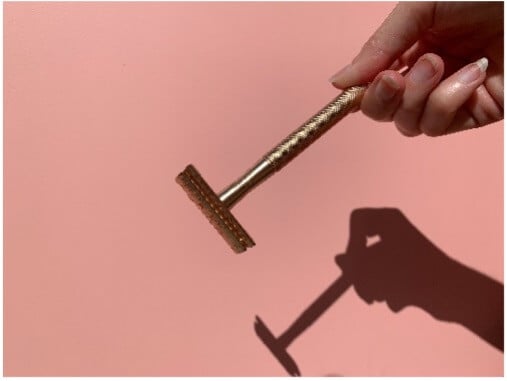
Methods such as shaving, waxing, chemical depilatories, or threading are known to be useful and affordable ways to control hair growth. However, they offer only a short-term effect that, in the case of PCOS, means higher maintenance and more frequent treatment due to the fast hair growth induced by hormonal imbalances. They may result in higher sensitization [6] of the skin, as well as skin redness and irritation [1].
For this reason, women with PCOS may benefit from other options, especially those that can give a more long-lasting hair reduction.
2.
Electrolysis
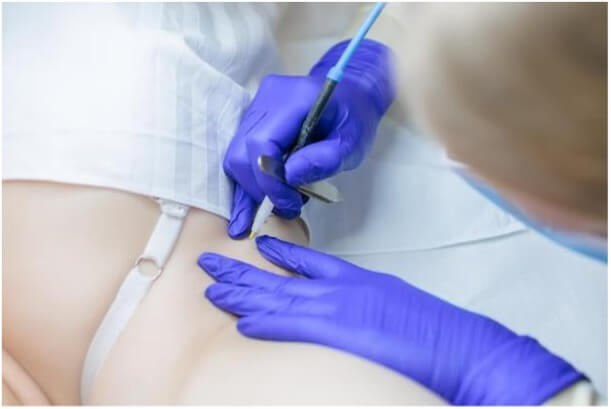
Electrolysis is the
long-lasting
hair removal method cleared by FDA for hirsutism. This method consists of the treatment of each hair by applying an electrical current through a fine needle that is inserted into the
hair follicle
[7] to induce its long-lasting damage.
The advantages?
Long-lasting hair removal. It can be used for any hair or skin color [7].
The disadvantages?
It is a painful, time-consuming, and costly technique that requires an experienced technician to perform it. Improper electrolysis can result in injuries, like pigmentation and scarring [8].
For all these reasons, laser and IPL devices have gained popularity as efficient and safe methods (backed up by several studies) to treat hirsutism in PCOS [6].
3.
Laser
Although lasers don’t offer long-lasting hair removal, they can provide a rather long-lasting hair reduction. Lasers are the most popular method currently cleared to treat hirsutism in PCOS. Indeed, a single session is expected to reduce hair by 10%–40% and repeated sessions by as much as 90%, with results persisting for up to 12 months [9].
How does it work?
Lasers can induce selective photothermolysis, consisting of the thermal destruction of the hair upon application of sufficient energy delivered
at a specific wavelength
that is absorbed by the melanin present in the hair. Dark hair that contains large amounts of melanin instantly absorbs these wavelengths and is most susceptible to laser-induced damage [10].
Which lasers are used?
Long pulse wavelength (600-1000 nm) lasers are preferred for better penetrance into the deep hair root. Namely, Alexandrite (755 nm), Diode (810 nm), and Nd: YAG (1064 nm) lasers are frequently employed for hair removal purposes [11], being Alexandrite the most effective one to treat hirsutism in PCOS [6][12].
The advantages?
Selective hair damage, less time consumption, longer hair-free interval, and fewer side effects [10].
The disadvantages?
It’s expensive and must be performed by a professional in a medical facility [1]. Possible adverse effects could happen in darker skin types, so individual characteristics and cutaneous response may be evaluated to select the best laser and appropriate settings [8].
4.
IPL
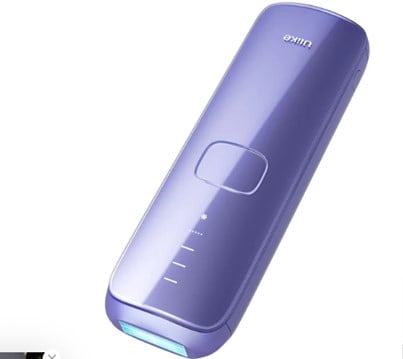
IPL stands for Intense Pulsed Light, which is a popular non-laser treatment also suitable to treat hirsutism in PCOS [6]. Like lasers, IPL devices can provide long-lasting hair reduction.
How does it work?
IPL consists of a high-intensity light source that emits non-coherent light covering a broad range of wavelengths (500 to 1200 nm). It’s also based on the principle of selective photothermolysis, targeting melanin at the hair bulb to cause its relatively selective thermal destruction at suitable wavelengths [6].
The advantages?
IPL offers the possibility to perform the treatment with
home-use devices
, which are reported to be as successful as laser systems because of the same thermal effect. It’s of a lower cost and larger spot size facilitating more rapid treatment [11].
The disadvantages?
It may require a greater number of treatment sessions to achieve the expected results [11]. Treatment may be more effective in those with lighter complexions and darker hair. Side effects such as pain, erythema, swelling, and pigmentation have been reported [8], but they tend to be infrequent and transient, being a safe method when used correctly [6].
Indeed, to avoid potential side effects, modern IPL devices are designed with cooling systems to protect the skin. For instance,
Ulike IPL devices
adopt the Sapphire Ice-Cooling patent technology
to offer a pain-free treatment.
WHY IS IPL THE MOST SUITABLE HAIR REMOVAL METHOD FOR PCOS?
It comes down to its many advantages and proven efficacy comparable to that of lasers.
IPL technology certainly can enable greater versatility and flexibility regarding therapeutic choices to manage hirsutism [11]. Being an affordable, convenient, safe, and easy-to-use alternative to effectively reduce unwanted hair at home, treating a variety of anatomic locations including larger surface areas affected by PCOS (such as the back, chest, and legs) due to its large spot size [13].
But let’s see the scientific evidence on this matter, shall we?
Although some studies have shown that the Alexandrite laser appears to be more effective at reducing facial hirsutism in women with PCOS compared to IPL [12], other studies have shown that IPL can be almost as effective as other types of lasers or even superior [6].
One study evidenced that after 6 treatments with IPL, patients with PCOS and without PCOS show the same safety profile and efficacy in terms of reduction of facial hair, hair thickness, and density [6], meaning that IPL is a suitable technique equally effective for hair reduction regardless of the condition. The percentage of hair reduction at the end of the study for the upper lip and chin was 52.87% and 73.81%, respectively [6].
Moreover, in terms of safety, most studies have found IPL to be more tolerable and have fewer side effects than lasers which can be attributed to IPL’s integrated cooling systems [6].
THE TAKEAWAY
Since most women with PCOS are expected to suffer from hirsutism, hair removal methods are excellent allies for removing unwanted hair. Lasers and IPL are the most popular methods for this purpose, helping in achieving a long-lasting reduction of hair after several treatments. However, the convenience and advantages of IPL over lasers place IPL devices as a top choice for women with PCOS, but it requires commitment and patience to achieve the desired results over time, along with the concomitant pharmacotherapy to treat the underlying hormonal imbalances associated.
REFERENCES
[1] Escobar-Morreale, H. F. (2018). Polycystic ovary syndrome: definition, aetiology, diagnosis and treatment. Nature Reviews Endocrinology, 14 (5), 270–284. https://doi.org/10.1038/nrendo.2018.24
[2] Ndefo, U. A. (2013, June 1). Polycystic Ovary Syndrome: A Review of Treatment Options With a Focus on Pharmacological Approaches. PubMed Central (PMC). https://www.ncbi.nlm.nih.gov/pmc/articles/PMC3737989/
[3] Spritzer, P. M., Marchesan, L. B., Santos, B. R. D., & Fighera, T. M. (2022). Hirsutism, Normal Androgens and Diagnosis of PCOS. Diagnostics, 12 (8), 1922. https://doi.org/10.3390/diagnostics12081922
[4] McGill, D. J., Hutchison, C. A., McKenzie, E. D., McSherry, E., & Mackay, I. (2007a). Laser hair removal in women with polycystic ovary syndrome. Journal of Plastic Reconstructive and Aesthetic Surgery. https://doi.org/10.1016/j.bjps.2006.11.006
[5] Moghetti, P., & Toscano, V. (2006). Treatment of hirsutism and acne in hyperandrogenism. Best Practice & Research Clinical Endocrinology & Metabolism, 20 (2), 221–234. https://doi.org/10.1016/j.beem.2006.03.003
[6] Thacker, P. M., & Kumar, P. (2016). Near infrared pulsed light for long-lasting hair reduction in Fitzpatrick skin types IV and V. Journal of Cutaneous and Aesthetic Surgery, 9 (4), 249. https://doi.org/10.4103/0974-2077.197078
[7] Rashid, R., Mir, S. F., Kareem, O., Ali, T., Ara, R., Malik, A., Amin, F., & Bader, G. N. (2022). Polycystic ovarian syndrome-current pharmacotherapy and clinical implications. Taiwanese Journal of Obstetrics & Gynecology, 61 (1), 40–50. https://doi.org/10.1016/j.tjog.2021.11.009
[8] Somani, N., & Turvy, D. N. (2014). Hirsutism: An Evidence-Based Treatment Update. American Journal of Clinical Dermatology, 15 (3), 247–266. https://doi.org/10.1007/s40257-014-0078-4
[9] Hosseini, M., Ehsani, A. H., Fakour, Y., Aryanian, Z., Elhamfar, M., & Noormohammadpour, P. (2022). Effect of Laser-Assisted Hair Removal (LAHR) on the Quality of Life and Depression in Hirsute Females: A Single-Arm Clinical Trial. Journal of Lasers in Medical Sciences, 13, e46. https://doi.org/10.34172/jlms.2022.46
[10] Bhat, Y. J., Bashir, S., Nabi, N., & Hassan, I. (2020). Laser Treatment in Hirsutism: An Update. Dermatology Practical & Conceptual, e2020048. https://doi.org/10.5826/dpc.1002a48
[11] Karaca, Ş., Kaçar, S. D., & Ozuğuz, P. (2012). Comparison of SHR Mode IPL System with Alexandrite and Nd: YAG Lasers For Leg Hair Reduction. Balkan Medical Journal, 29 (4), 401–405. https://doi.org/10.5152/balkanmedj.2012.033
[12] McGill, D. J., Hutchison, C. A., McKenzie, E. D., McSherry, E., & Mackay, I. (2007b). A randomised, split-face comparison of facial hair removal with the alexandrite laser and intense pulsed light system. Lasers in Surgery and Medicine, 39 (10), 767–772. https://doi.org/10.1002/lsm.20584
[13] Goldberg, D. J. (2012, June 1). Current Trends in Intense Pulsed Light. PubMed Central (PMC). https://www.ncbi.nlm.nih.gov/pmc/articles/PMC3390232/

 By myulikeadmin
By myulikeadmin




